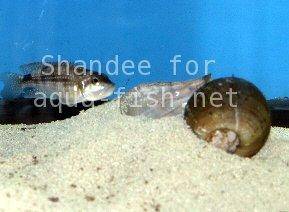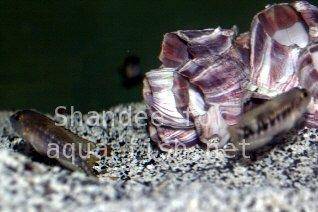Lamprologus species
Quick links
Lamprologus is actually a temporary genus used to name some of the cichlids found in Lake Tanganyika. It is believed that the Lamprologus genus is restricted to the Riverine Species and not found in Lake Tanganyika. Currently Caudopunctatus, Ocellatus, Similis, Speciosus and Multifasciatus are among some of the cichlids found in Lake Tanganyika that are temporarily assigned to the Lamprologus genus.
Lamprologus caudopunctatus
Lamprologus caudopunctatus is an amazing and very intelligent species. They are found in shallow water and they feed on plankton. They live in shells or small caves, and usually in large numbers. L. caudopunctatus usually have an orange or yellow colour to their dorsal fin. When they are stressed they display dark grey vertical stripes through their body, and their eyes have a blue glow. When they breed it is either inside shells or small caves. L. caudopunctatus do not eat their young, in fact the fry from each spawn will take a roll in the care and hatch of the eggs in the following spawns. They will do fine in a tank as small as a 10 gallon. You should keep a few shells and small caves, even layered slate with small cave like crevices for them to seek shelter. Some types of the L. caudopunctatus prefer caves to shells, so by placing both in the aquarium you can see which they prefer.
Lamprologus ocellatus
Lamprologus ocellatus is a beautiful species with a mild to calm temperament. They live in shells with a muddy or sandy substrate. This species has many colour morphs from gold to purple. They are best kept in pairs or trios. In your aquarium you should have at least 2 shells per fish and a few more for fry. The male will guard many shells and usually even covers them completely so he has less to guard and also to force the female into his shell to breed. That shell will then become the females shell and she will stay in the shell and care for the eggs until they hatch. The eggs from the Ocellatus are very small and yellow in colour. The eggs hatch within a week and small fry can be seen at the bottom of the shell. The female will usually dig a small bowl in the sand or mud near the shell. The female will let the small fry swim around and play in the bowl. After about two weeks she will let the fry venture off on their own. The male will also help guard the bowl with the fry until they “move out”. The L. ocellatus can be house in a tank as small as 10 gallons. The females will not get much larger than two inches, and males are full grown at about 2.5 inches. The picture below shows an adult male L. (meleagris) “Pearly Ocellatus”.

Lamprologus similis
Lamprologus similis is another interesting shelldweller. They live in shells found in sandy or muddy areas in the lake, just like many other shelldwellers. In my experience with this species, I have noticed that they are more reserved and really seem to keep to themselves. The fry from the L. Similis will also help care for new spawns, also as seen in the L. caudopunctatus. The L. similis seem to have smaller broods of about 3-6 fry at a time, where as other shelldwellers seem to have broods of about 8-12 fry at a time. The L. similis are very calm and skittish. I would recommend keeping the L. similis in their own tank or with other calm cichlids from Tanganyika. Some examples of good tank mates would be Cyprichromis leptosoma, Paracyprichromis, and even Altolamprologus. Those genuses will occupy different levels of your aquarium giving all the species their own territories.
Lamprologus speciosus
Lamprologus speciosus are one of the most aggressive shell dwellers. They have dark beautiful colours that come out most when they are courting. They will take care of their fry for about two weeks then the adults will allow them to roam the tank. The fry can stay in the same tank with the parents as long as there are plenty of shells and or rock caves for them to hide in. Lamprologus speciosus thrive in a lower pH of 8.0 – 8.4, it’s ideal for them and will also speed up breeding. Speciosus like to feed on algae and other plant life as well as brine shrimp and plankton. They will also eat small pellets and flake food. These shelldwellers are very interesting to watch. They are harder to find than other shell dwellers, but they are very entertaining. The substrate in the tank should be sand. L. speciosus like to bury their shells and make bowls in the sand for their fry. They will also bury themselves in the sand if they can’t find a shell or cave to hide in fast enough. I would recommend L. speciosus to anyone who is interested in shell dwellers. They can also be housed in a 10 gallon tank and do just fine. The picture below is L. speciosus guarding their territory.

Lamprologus multifasciatus
Multifasciatus were once only known as Lamprologus multifasciatus, but now they are also known as Neolamprologus multifasciatus. This shell dweller is known also as the smallest cichlid in the world. Males will grow to 1.5 – 2.0 inches and females will grow to .75 – 1.0 inches. Because the Multifasciatus are so small they only have a few fry at a time. The fry can be kept with the parents and it is best to just keep them in their own tank with no other species. Multifasciatus will not bury their shells the way other shell dweller do. They like to dig a bowl in the sand and have their shell inside the bowl. They will dig to the bottom of the aquarium no matter how deep the sand is. It is hard to see them spawn because both parents are small enough to fit into the shell and their spawning is usually unnoticed. I would recommend this cichlid to any who wants to watch them decorate the tank with sand bowls. They are very enjoyable and easy to care for. They feed on flakes and baby brine and anything that is small enough for them.
Lamprologus shell dwellers are a nice addition to a any tank. Some will do best in their own tank, but all of them have such a unique temperament. They love to make their home in empty shells or caves and also love to dig and hide in the sand. All the Lamprologus shell dwellers are a great choice if you have a space limitation.
